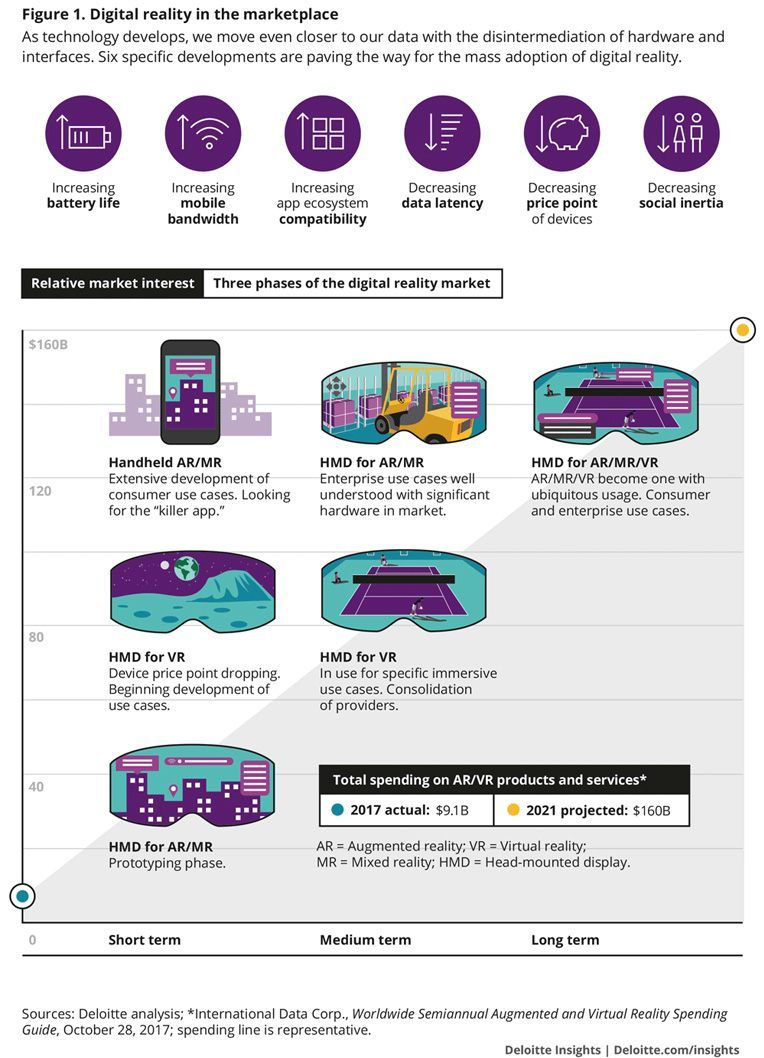Digital Reality: Changing how we interact with data
This content is from our sponsor. Fox Business editorial was not involved in the creation of this content.

Following suit with the latest technologies outlined in Deloitte’s ninth annual Tech Trends report, digital reality—a mix of augmented reality (AR), virtual reality (VR), mixed reality, 360°, and immersive technologies—is another disruptive technology previously anchored in the consumer world making a transition into the enterprise.
As explained in “Digital reality—the focus shifts from technology to opportunity,” many technological advances in this field previously came in the gaming and entertainment areas, but there has been a shift from “shiny object” devices for consumers to applications in the workplace.
The technology is at various stages between early adopters and those creating prototypes, but Deloitte believes it will gain momentum over the next 18 to 24 months. Supporting that claim, the International Data Corp. (IDC) projects that total spending on AR/VR products and services will skyrocket from $9.1 billion in 2017 to nearly $160 billion in 2021, representing a compound annual growth rate of 113.2 percent.[i]
A More Intuitive Experience
Digital reality can help break down geographic and systemic barriers, leading Deloitte to believe that it will transform the way we experience the world and interact with data.
As the means of interacting with digital information shift from screens and hardware to a more natural and intuitive experience, Deloitte sites three specific design breakthroughs that are being incorporated into digital reality systems.
Transparent interfaces will make it possible for users to interact with data, applications, and environments more naturally with a blend of voice, body, and object controls. With ubiquitous access, people can be connected and stay engaged for hours due to more comfortable AR/VR devices no longer limited by cord length. An adaptive level of engagement would allow for customizing the data that appears in a virtual environment based on preferences, locations, and activities.
Digital Reality Opportunities
For a company beginning the journey to integrate digital reality into their business, Deloitte suggests first learning more about the technology. Traditional IT skillsets don’t really apply, and implementation involves new designs, new tools and services, and a new vocabulary.

Checking out competitors and comparing what others in adjacent industries are doing can also help uncover potential opportunities. Deloitte stresses developing use cases without worrying about perfection. The technology is changing so quickly, and as it evolves, so will strategies. Businesses should not be put off on starting until they can achieve perfection.
Deloitte outlines five specific areas of opportunity:
Connect: Today’s technology already removes some of the location barriers, but digital reality goes a step further and creates immersive interactions so that teams can work on or view digital models or assets together in real time, or watch as workers in the field explore a problem off-site.
Know: Digital reality can provide precise, visual information exactly when needed regardless of location. Imagine putting on a pair of digital reality glasses to view construction maps or part specs in order to make repairs.
Learn: Digital reality can be used to “immerse trainees in lifelike situations that would be too expensive or logistically impossible to create on the ground.” Using this technology, employees can receive valuable training in more practical and cost-effective situations.
Explore: In areas such as retail, real estate, and hospitality, vendors can demonstrate products and services to customers digitally, potentially changing the way merchants work and consumers buy goods.
Play: The International Data Corp. (IDC) projects that investment in AR/VR gaming use cases alone will reach $9.5 billion by 2021, so the use of digital reality in the gaming industry is not slowing down any time soon.[ii]
Navigating Headwinds
While still too early to measure the full impact of digital reality on IT ecosystems, the coming technology could be impeded by limitations of storage and bandwidth. It’s estimated that providing 360° views in VR could require 10-20 times the storage capacity needed to play a standard HD video file. Meanwhile, it’s a challenge finding a network that can provide the bandwidth speeds required.
Cybersecurity is another area where digital reality will have major implications, as there will be a whole new virtual world that needs securing. Identity and authentication procedures may not be as simple as logging in with a password, and data protection policies will need to be created.
Creating a digital reality environment is a very different process than creating experiences for a screen. Deloitte explains that it utilizes new languages, patterns, and design techniques that will have to be invented by a new generation of programmers. Despite the challenges and unknowns as the technology evolves, digital reality is on its way to changing how people experience and interact with data and the world around us.
Click Here for More Insights from Deloitte
Authors: Allan V. Cook, Ryan Jones, Ash Raghavan, and Irfan Saif
[i] International Data Corp., Worldwide Semiannual Augmented and Virtual Reality Spending Guide, October 28, 2017.
[ii] International Data Corp., Worldwide Semiannual Augmented and Virtual Reality Spending Guide.




















